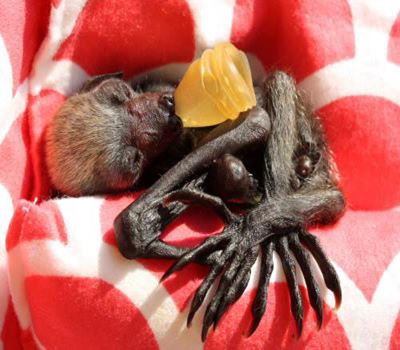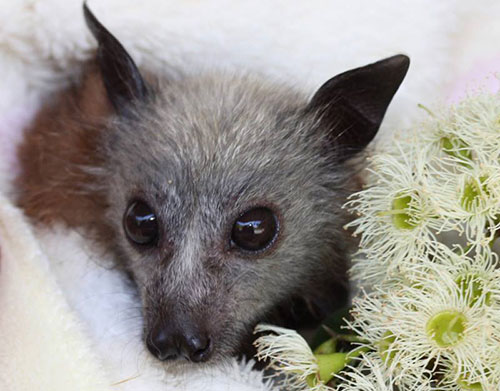Look at me now
Wednesday, January 13, 2016
Three months ago, the first bat pup of the season in the Northern Rivers area of NSW came into care.
He was a premature newborn Grey-headed flying-fox, weighing only 46 grams, well below normal birth weight. Grey-headed flying-foxes are categorised as vulnerable on the national Threatened Species list.
Attempting to raise a pup like this is a delicate task and uncertain in its outcome. The tiny male was kept in a humidicrib for the first few weeks and would take less than 1 ml of special formula per feed.
Flying-fox pups normally open their eyes immediately after birth; however, this little guy did not open his eyes until he was 11 days old. As the weeks went by, he continued to grow and finally convinced carers that he would indeed survive.
Now at nearly 300 grams and flying, he is enjoying blossoms and fruit and will soon be released with other flying-fox orphans.
Flying-foxes are one of only a few wildlife species which benefit from forming a bond with a human.

WIRES carers have to be careful not to humanise most wildlife species. Flying-foxes, however, bond with their human carer for the first 10 weeks of life then, just like human teenagers, only want to mix with their own kind and are no longer interested in their primary carers.
All bat species are very special; they are the only true flying mammal. And as nature’s nocturnal gardeners, they are the only long distance nocturnal pollinators of particular hardwood trees and carriers of rainforest seeds.
Did you know there are more than 70 species of bats in Australia? Of those 70, approximately 10 are flying-foxes.
Learn more about what to do if you come across an injured, sick or orphaned flying-fox or microbat.

Recent Posts
Celebrating World Earth Day: The History of Environmental Action and Collaboration
Feathers of Change: Native Duck Identification Project
NSW Koala Strategy Under Review Amidst Threat of Extinction
WIRES Teams Up With SES To Save Black Swan
Celebrating National Eucalypt Day
WIRES National Grants Support Heathcote Local to Landscape Project
WIRES and Taronga Team Up To Deliver World-Leading Platypus Facilities
WIRES Research Grant Recipient Aims to Protect Platypus Populations
WIRES Vet Dr. Tania Bishop's Wildlife Journey
Securing Koala Survival: Appin Road Wildlife Crossings Fall Short, Urgent Need for Overpasses
